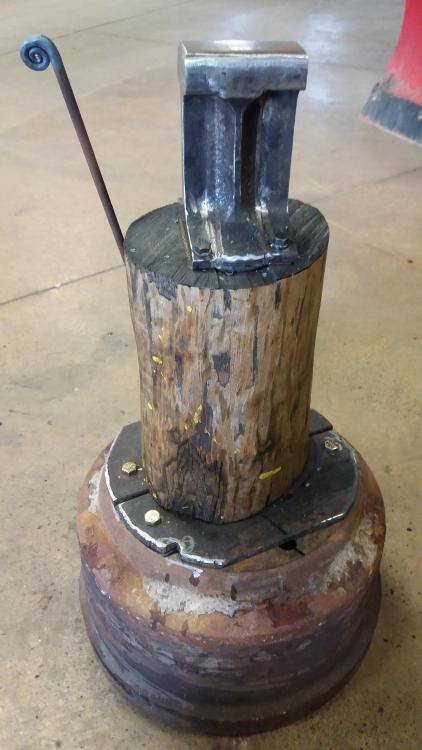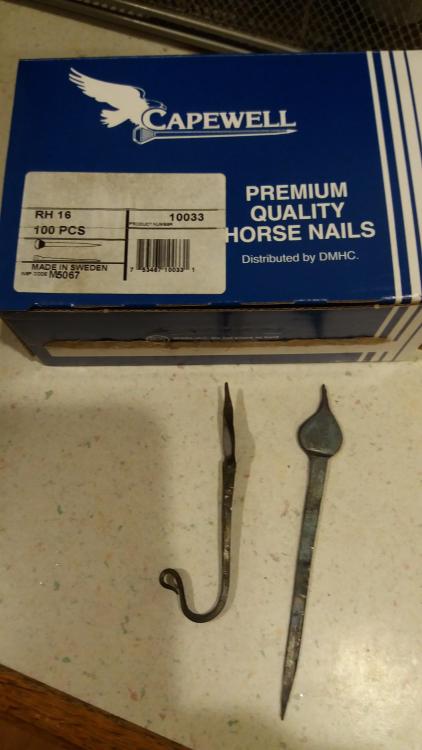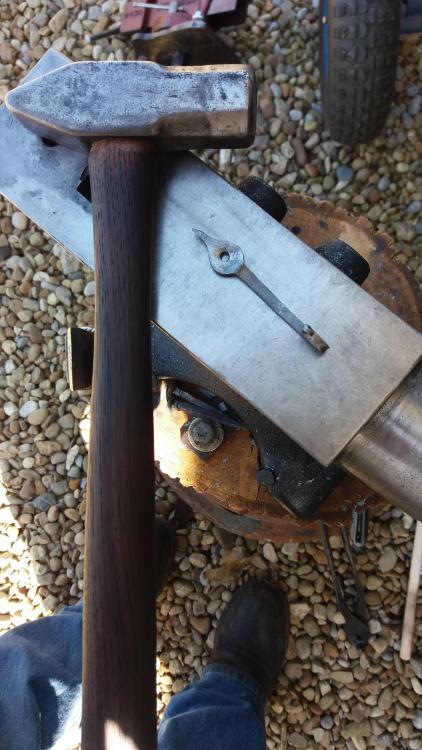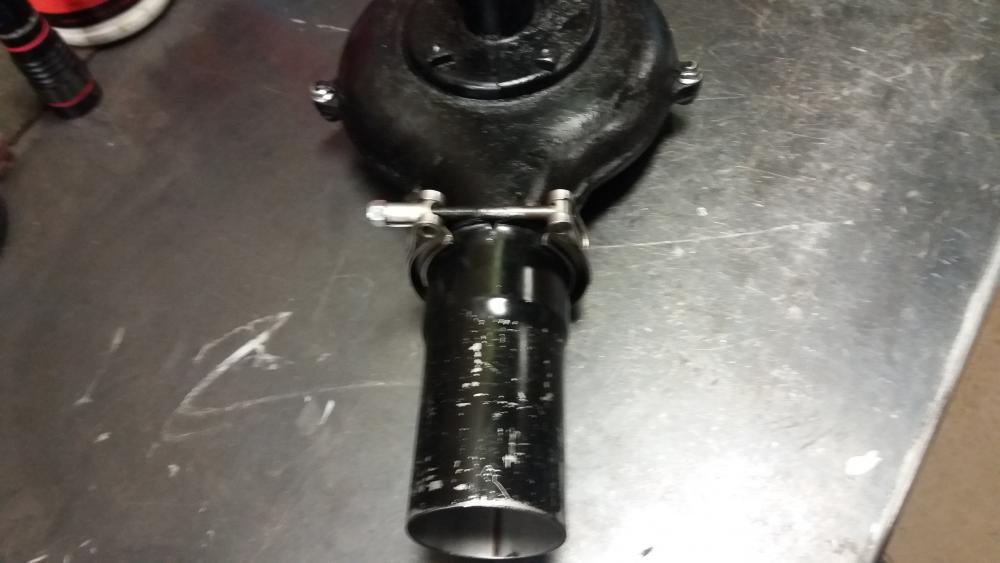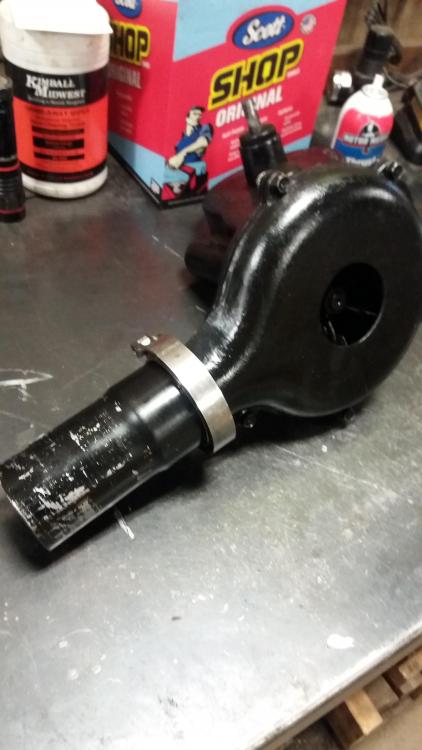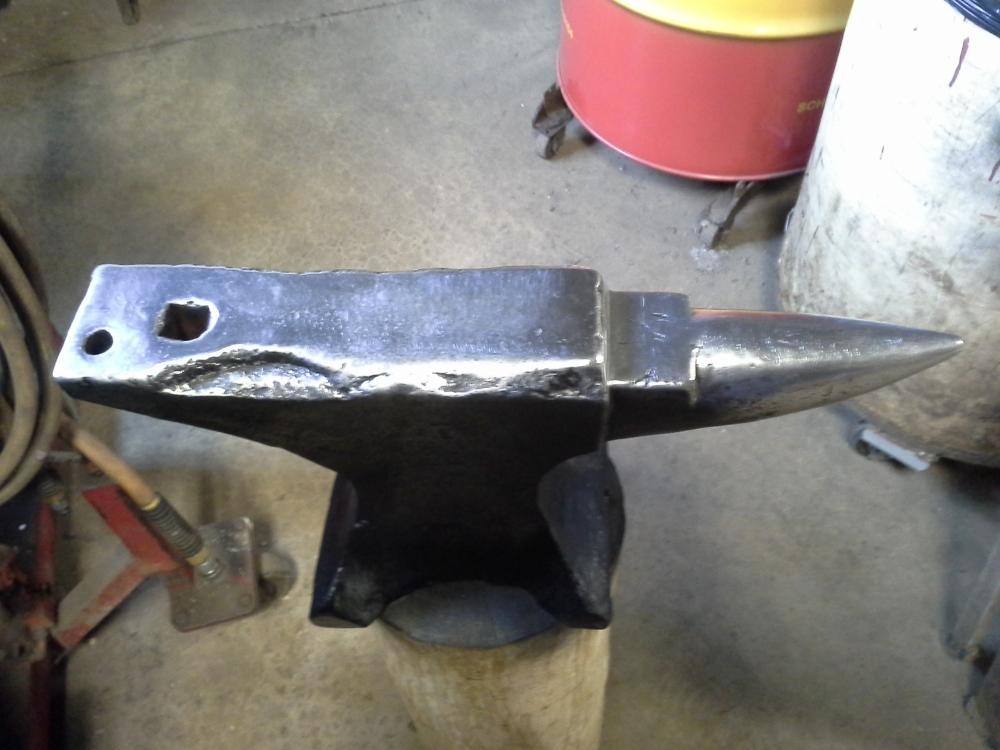-
Posts
1,227 -
Joined
-
Last visited
Content Type
Profiles
Forums
Articles
Gallery
Downloads
Events
Everything posted by SReynolds
-
Myself as well. All i have are high dollar anvils and thought it cool if i could build one from scrap i have. Cost me next to nothing. I did have to buy a heavy walled tubing for hardie tools. When i pick that up and weld it on, i will be pretty close to done. I used it a bit and it does work. Need the hatdie hole tubing to make it fully functional.
-

Projects and Materials for a Beginner
SReynolds replied to Arkham's topic in Blacksmithing, General Discussion
It isn't my place to tell folks where to begin. This is what i was shown as a beginner and worked for me (to learn controlling hammer and reading stock movement) I was shown the method of forging the nail head to a nickel or quarter sized (round) finial for a small hook. My first hundred or more looked like the country of Australia. Not a round quarter dollar coin. I developed the candle-flame finial lesson from a student who bet be to forge a flame from a nail head. I have mentioned this exercise in the past. One site member suggested forging a nail first. Then the finial and hook. But my point is; you cant. Not if you are a beginner (or student in a class) There is enough frustration for student learning how to forge a circle from a square-ish nail head. I suppose i could take that another step and make them walk down hill to the river and dig for iron ore. A box of shoe nails are very inexpensive, if you dont know. I have them try nails (from 1/4" square) but they cannot make a consistent head. So I thrown down some nails and they practice hammering on them. -

Projects and Materials for a Beginner
SReynolds replied to Arkham's topic in Blacksmithing, General Discussion
These are fun (to watch students make) take you a box of horse shoe nails and forge a flame finial. The scroll an eye and then a hook. Punch a hole cold in the thin finial. You could teach nail making and forge the flame hook from that. But the head needs to be beefy and paper thin wafer. Another episode I use is the nickel - sized circle from the same nail. Ultimate lesson in hammer control. -

Projects and Materials for a Beginner
SReynolds replied to Arkham's topic in Blacksmithing, General Discussion
It seems most begin with knives. Cant make a taper/no hammer control, but that's old school and modern folks aint got time for that. I begin students with 1/4" square stock tapers. Some do fair. Others cannot make anything that resembles a taper. But that is my wax-on/wax-off approach and i think they appreciate that when they prove to themselves they cant even make an S-hook from 1/4" square -
-
Just follow everything Brian does. He seems to be the leader and knows what to do. Why think for ourselves when someone else can tell us why? Sarcastically speaking of course.
-
I like a truck brake drum as it makes for a very stable base i.e. the foot print is very small and works very very well on nearly any surface. Flat or irregular. I use a large section of log in which to mount the anvil upon. The log is lag screwed to the flange of brake drum. I'm talking about a truck drum; 16.5" shoes by 8-5/8" wide and 11-plus inches deep. From a truck. You need a log diameter about 14" minimum to mount the drum to the face of the flange. There are ten holes there to run some large lag screws through. About 13-15" tall depending on height of anvil......and your hand. 100 pounds? 150? Then the log. Very secure base. Dirt cheap. Folks are asking me to provide them with drums and logs. I have better things to do, honestly. The cool factor is I can roll it anywhere.
-

using normal wood
SReynolds replied to mrkiddi's topic in Solid Fuels: Coal, Coke, Charcoal, Wood, etc
If you search link removed and select blacksmith items you will see two sizes of wood fired blacksmith forges. If i knew how, I'd post a link. It doesnt look like a forge, but it is. He has loaded a number of videos on his channel (YouTube) featuring that forge. He isn't an environmentalist. He just happens to own a forrest. Thus the wood. -

using normal wood
SReynolds replied to mrkiddi's topic in Solid Fuels: Coal, Coke, Charcoal, Wood, etc
Sorry; what i meant was he converts the raw wood into charcoal directly in the forge. -

Anvil care question from a newcomer
SReynolds replied to WHP67's topic in Anvils, Swage Blocks, and Mandrels
I take advice literally. Stilly trying out the experiment of self combustion of the boiled linseed oil wrags. I'll post back when that happens. To speed the process, I grabbed one of them and put a torch to it. It would not burn with out the torch. I use a coating of engine oil on the face/horn. I don't find that problematic when I begin to use it as I wipe it off...... I tried out WD-40 but it literally evaporates and the surface rusts. To make my custom patina on a painted anvil; I clean to bare metal.wipe with paint thinner or surface prep. Spray with black paint. Allow to dry. Lightly sand the surface with scotch brite and remove any overspray from face/horn etc. Wipe down with boiled linseed oil and save the wrag for above experiment. I may have some pictures on my office computer. My phone was stolen along with lots o pictures. -
Yes. The Canedy Otto Royal Western Chief is an oil bath. Fill to the fill level cast directly onto the gear box i.e. the valve. Light oil. Adjust the crank arm to suit you. I have an all original which contains no wood, plastic, bamboo, saw dust and resin impregnated gears.
-
Sorry to hear. I have heard about gears like that as well as gears so badly worn they are pointed at the ends. I can only surmise you have the early version. The fellow at Georgia Museum of Agriculture posted completely replacing every moving component on YouTube. Look it up. Other YouTube video from folks pointed out a company that sells gears and quite possibly shafts. Yes, you can rid yourself of that plastic-like gear. My late model Royal is all original and no plastic-like gear. You have the large free standing blower or the smaller forge mounted unit?
-
Not sure what model you are getting but can tell you this; these are exquisite units. I bought a late model one year ago (12") because i could. All original. Even the red paint and wood handle. Took it apart one year later (last weekend) to see what I'd have to do. It was sorta cruddy but in super shape. I couldn't believe it. If you are familiar with the champion 400 , this thing is far and away better. The 400 is as if champion took the most expensive , complex and most difficult route. The Royal blower is very simple. Very. Simple. Virtually zero noise. And these are all spur gears! Smooth like home made ice cream. There are early versions which employed a plastic-ish gear. I guess they can be problematic. There are two sizes. The small one was mounted on the forge via a collar. The larger blowers were available free standing like yours. The gear case will hold almost one pint of light machine oil. It is not sealed! If you overfill, it will spew out the fan shaft. If you tip it over, it wil run out. It will have a drain via the oil level valve. I used mine for first time yesterday. It was like eating a warm peach cobbler under a blanket of home made vanilla ice cream. I have a pic somewhere on my computer.........
-
These are the 9" and mounted direct to the forge. They are not intended to mount on the factory stand. You can and i have, used this blower as a free-standing unit next to a large cast iron free-standing forge. The difficulty is connecting the air duct to these as they have a very small flange. Unlike the 12-14-16 inch blowers, which have a larger flange intended to connect the air pipe. I made a mating flange on the end of a section of 3" exhaust pipe and used a v-band clamp from a turbo flange to connect the pipe to blower flange outlet. That way; I have a short section of 3"pipe to connect the flex pipe onto. I cannot tolerate duct tape. The disassembly of these can be harrowing. If you dont have specific instructions. These employ ball bearings and the inner/outter races wear and become rust pitted. They can be quite noisey. Replacing the balls is not a problem. But races are not available. They are not intended to hold oil. Light machine oil is fine. Not a gear lube. I literally use diesel fuel with some engine oil mixed into it. You can make a clamp from two opposing sections of angle iron. 1/2" I think....... Be happy to send some pics but most of them were stolen from me. Along with my phone. I should have some pics on my laptop at the garage. Search YouTube for restoring these 400 blowers.
-

using normal wood
SReynolds replied to mrkiddi's topic in Solid Fuels: Coal, Coke, Charcoal, Wood, etc
On his own YouTube channel demonstrates how to forge with wood. Wood that is. Not charcoal. The forge looks special however. Unlike what i have seen. His is commercially available. He bought it somewhere like amazon. But you can make one. He isnt a blacksmith but does try it sometimes. And uses doug fir i believe. -

Anyone know an anvil repair service?
SReynolds replied to Nicholas_Killmeier's topic in Anvils, Swage Blocks, and Mandrels
Yes. Rufflinghaus rebuilds anvils. Send it. They are like new. -

New anvil . But not as I hoped
SReynolds replied to eco redneck's topic in Anvils, Swage Blocks, and Mandrels
I tried that at the anvil store. It didn't work out. I says; how much for the 70 pound Fisher? Tells me threehundred dollars because it is nice shape with flat surface and sharp edges. So I says; but I read blacksmiths want sway back face and chipped/rounded edges. .........and that reasoning went over like a screen door on a submarine. He wants to know why he would charge more for a worn-out anvil as opposed to new...... I go to this national historical park and visiting with the full-time smith. Pointing out his near mint HB anvil with flat face and cripsy edges. He literally bragged how flat the face is for an old anvil and the quality of said article. Yea, the sway-back and beat-up corners obviously do not hold up in an argument with a old full-time smith nor an anvil dealership. I should charge more for my car with rust, worn tires, leaking radiator and 187,000 miles. -

M&H Armitage Mouse Hole Anvil repair
SReynolds replied to ringeter's topic in Anvils, Swage Blocks, and Mandrels
-
See there is an HB advertised on eBay made entirely from steel (not wrought and steel) with 100% rebound. Would that be a discovery (realization, not the Horse) of perpetual motion? Will this anvil solve the world's energy issues?
-

can we agree to disagree?
SReynolds replied to SReynolds's topic in Blacksmithing, General Discussion
All interesting reading. Especially "check the source of the source" -
I normally use the bellows. But do not have a preference. The old crank blowers do quite well. I have used electric foot operated switch and that was fun.
-

can we agree to disagree?
SReynolds replied to SReynolds's topic in Blacksmithing, General Discussion
Correct. Simple brine solution. Apparently the published experts don't agree. One recommended used engine oil and if you mention that on a Facebook group for blacksmiths, they will all but ban you from the group. -

can we agree to disagree?
SReynolds replied to SReynolds's topic in Blacksmithing, General Discussion
Probably not to be taken literally. I would say. I had a class of 14 high school students today in which I did a heating demo for the industrial arts class and was cautious to only give technical information and not opinion. -
Two popular smithing books. Two different opinions on technical information. I thought technical info is cut and dry. Not opinion. So one smith says salt brine cools the work quicker than water. Another says cools slower than water. I was asking a well known smith a technical question and when I asked him to clearify he replied that I take information too literally. So I have been thinking about that today. What technical information should we take literally and what should we pass off as opinion?

